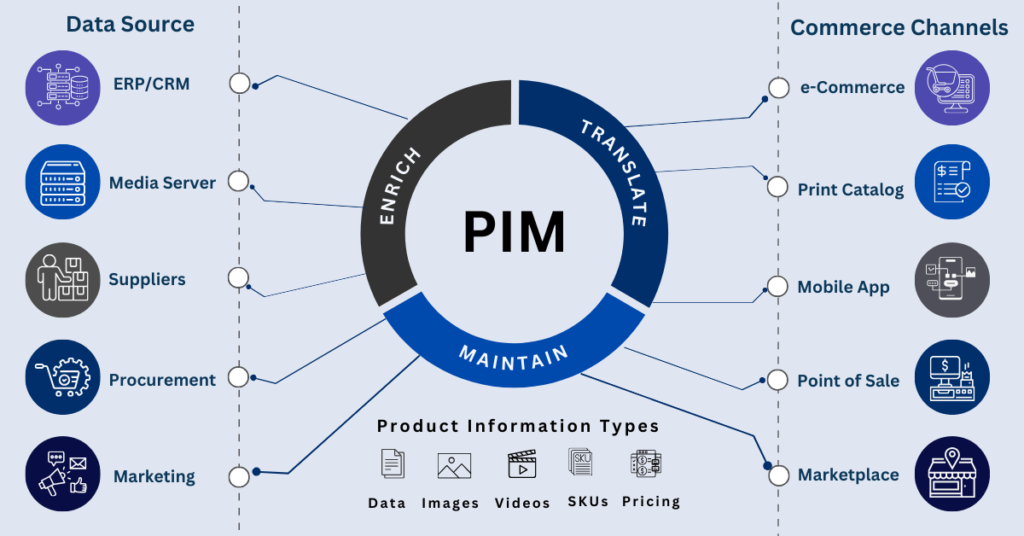Mastering Product Data Syndication: A Business-Centric Approach In today’s fast-paced digital marketplace,

What is PIM?: How It Works, Why It Matters, and Who Benefits
In our rapidly evolving digital era, businesses are continuously pursuing innovation to maintain a competitive edge. The effective management of product information is pivotal for success across various industries. In this insight, we’ll delve into the realm of Product Information Management (PIM) and delve deeper into its crucial role in modern business operations.
What Is Product Information Management (PIM)?
Product Information Management (PIM) is a business process that centralizes and streamlines the management of product information. By consolidating data from multiple sources and enriching it for marketing and sales purposes, PIM system provides a single, reliable repository of product data, also known as the golden source of truth. This ensures that consistent, accurate, and complete product information is available across all customer touchpoints, from eCommerce platforms to social media channels.
How Does a PIM System Work?
A PIM system acts as a centralized hub for managing and distributing product data in complex software environments. It synchronizes data from multiple sources, ensuring transactional and bidirectional data flow. Unlike systems like Product Data Management (PDM) or Product Lifecycle Management (PLM), PIM focuses primarily on sales and marketing, enabling businesses to create compelling product narratives that drive customer engagement and conversion.

Key Functions of a PIM System
PIM systems streamline and optimize product data management through four core functions:
1. Data Collection:
PIM aggregates data from diverse sources such as ERPs, CRMs, OMSs, and warehouse systems. This includes importing product attributes, mapping them, and transforming them into a standardized format for further use.
2. Data Consolidation:
Duplicate entries and inconsistencies in product data are resolved through cleaning, deduplication, and consolidation processes, creating a unified, trustworthy source of information.
3. Data Enrichment:
Product information is categorized, classified, and enhanced with additional attributes and media, including images, videos, and descriptions. These enrichments help contextualize products for different audiences and channels.
4. Data Dissemination:
PIM systems map and publish product information to various customer-facing platforms, such as eCommerce websites, marketplaces, social media, and print catalogs. This ensures consistent messaging across all channels.
When Do Businesses Need PIM?
Signs that your organization might need a PIM system include:
- Increasing SKU volumes overwhelming existing systems.
- Lack of a single source of truth, leading to interdepartmental miscommunication.
- Customer complaints about inconsistent product information. Delays in product launches and longer time-to-market.
- Challenges in managing product data for global operations, such as translations and regulatory compliance.
Implementing a PIM System:
Implementing a PIM system can be a transformative process for businesses. Here are the key steps to consider:
- Assessment: Begin by assessing your current data management processes and identifying pain points. Determine your specific goals for implementing a PIM system.
- Choose the Right PIM Solution: There are various PIM solutions available, ranging from on-premises to cloud-based systems. Select a solution that aligns with your business needs, budget, and scalability requirements.
- Data Migration: Transfer existing product data into the PIM system. This may involve cleaning and standardizing data to ensure accuracy.
- Data Enrichment: Enhance your product data with additional information such as images, videos, and marketing content. This step is crucial for creating compelling product listings.
- Integration:Integrate the PIM system with other business applications, such as e-commerce platforms, ERP systems, and CRM software, to ensure seamless data flow.
- Training: Provide training to employees who will be using the PIM system to maximize its benefits and efficiency.
- Maintenance and Updates: Regularly update and maintain your product information management system to keep it aligned with changing business needs and evolving product information.
Benefits of Implementing PIM
A robust PIM system brings transformative benefits to businesses:
- Centralized Product Data: PIM consolidates data scattered across systems, departments, and locations into a single, reliable repository, ensuring all teams work with consistent and accurate information.
- Operational Efficiency: By automating data updates, validations, and syndication, PIM eliminates manual errors, streamlines workflows, and saves time.
- Scalability: As businesses grow, PIM enables seamless management of larger product catalogs, diverse SKUs, and expanded sales channels.
- Globalization Support: PIM ensures uniformity in multilingual product descriptions, currency conversions, and compliance with regional regulations, enabling smooth international operations.
- Accelerated Time-to-Market: By optimizing data management processes, PIM reduces the time required to launch new products or update existing ones, enabling businesses to stay competitive.
- Enhanced Customer Experience: High-quality, enriched product data empowers customers to make informed purchase decisions, boosting satisfaction and reducing return rates.
How PIM Transforms Business Operations
A PIM system acts as a catalyst for business growth by:
- Reducing Time-to-Market: Consolidated product data eliminates delays, allowing businesses to launch products faster.
- Driving Higher Sales: Accurate and enriched product data resonates with customers, increasing conversions and reducing returns.
- Streamlining Workflows: Role-based access, real-time updates, and automated approvals improve collaboration and reduce bottlenecks.
- Supporting Marketing Campaigns: PIM solutions aligns product information with campaign goals, enhancing targeting and ROI.
- Simplifying Catalog Creation: PIM facilitates faster generation of digital and print catalogs, enabling businesses to adapt to market trends quickly.
Who Benefits from PIM?
Several departments across the value chain actively use PIM systems, including:
- Marketing and Sales: To craft compelling product narratives and personalize customer experiences.
- eCommerce Managers: For efficient product content updates and channel-specific customizations.
- Product Managers: To manage data attributes and coordinate updates with suppliers and teams.
- Suppliers: For transparent collaboration and streamlined data exchanges.
- Customer Service Teams: To access real-time product information for resolving customer queries.
The Role of Technology in PIM’s Evolution
Modern PIM systems leverage technologies like Gen AI and Machine Learning (ML) to enhance efficiency and deliver advanced capabilities:
- AI-Powered Automation: Speeds up data onboarding, enrichment, and validation, while improving localization and customer experience.
- ML for Classification and Insights: Automates product classification, extracts insights from unstructured data, and personalised customer recommendations.
Key Takeaways:
Product Information Management (PIM) is no longer a nice-to-have system but a critical business tool for managing product data in today’s competitive landscape. By centralizing, enriching, and distributing accurate product information, PIM empowers businesses to deliver superior customer experiences, drive efficiency, and achieve scalability.
Whether you are struggling with disorganized product data, facing delays in product launches, or aiming to deliver personalized product experiences, a robust PIM platform can transform the way you manage and showcase your product offerings. Embrace the power of PIM to unlock new growth opportunities and stay ahead in the dynamic world of digital commerce.
To discover the benefits that PIM can bring to your organization, please get in touch with us to arrange a demo.
Latest Resources
Discovering Advanced Product Information Management (PIM) Capabilities Enterprises Demand in 2025 In
Get the Most Out of Your PIM Demo: 10 Essential Questions to
Customer Experience Trends 2025: Transforming CX with Generative AI and PIM Despite
5 Must-Have Strategies for Managing Product Catalogs During the Holiday Rush The
Holiday Rush: When Managing Product Data Feels Like a Marathon As Thanksgiving
Leveraging PIM for Managing Compliance and Regulatory Data in the Manufacturing Industry
Table of Contents OverviewToday’s digital landscape has transformed the customer journey, with
From Browsing to Buying: The Impact of Product Information on Customer Satisfaction
The Future of PIM in E-Commerce: AI’s Role in Enhancing Omnichannel Strategies










